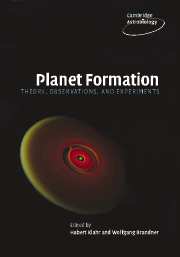Book contents
- Frontmatter
- Contents
- Preface
- Acknowledgments
- 1 Historical notes on planet formation
- 2 The Formation and Evolution of Planetary Systems: placing our Solar System in context
- 3 Destruction of protoplanetary disks by photoevaporation
- 4 Turbulence in protoplanetary accretion disks: driving mechanisms and role in planet formation
- 5 The origin of solids in the early Solar System
- 6 Experiments on planetesimal formation
- 7 Dust coagulation in protoplanetary disks
- 8 The accretion of giant planet cores
- 9 Planetary transits: a first direct vision of extrasolar planets
- 10 The core accretion–gas capture model for gas-giant planet formation
- 11 Properties of exoplanets: a Doppler study of 1330 stars
- 12 Giant-planet formation: theories meet observations
- 13 From hot Jupiters to hot Neptunes … and below
- 14 Disk–planet interaction and migration
- 15 The brown dwarf–planet relation
- 16 Exoplanet detection techniques – from astronomy to astrobiology
- 17 Overview and prospective in theory and observation of planet formation
- References
- Index
Preface
Published online by Cambridge University Press: 14 September 2009
- Frontmatter
- Contents
- Preface
- Acknowledgments
- 1 Historical notes on planet formation
- 2 The Formation and Evolution of Planetary Systems: placing our Solar System in context
- 3 Destruction of protoplanetary disks by photoevaporation
- 4 Turbulence in protoplanetary accretion disks: driving mechanisms and role in planet formation
- 5 The origin of solids in the early Solar System
- 6 Experiments on planetesimal formation
- 7 Dust coagulation in protoplanetary disks
- 8 The accretion of giant planet cores
- 9 Planetary transits: a first direct vision of extrasolar planets
- 10 The core accretion–gas capture model for gas-giant planet formation
- 11 Properties of exoplanets: a Doppler study of 1330 stars
- 12 Giant-planet formation: theories meet observations
- 13 From hot Jupiters to hot Neptunes … and below
- 14 Disk–planet interaction and migration
- 15 The brown dwarf–planet relation
- 16 Exoplanet detection techniques – from astronomy to astrobiology
- 17 Overview and prospective in theory and observation of planet formation
- References
- Index
Summary
With the words “Twas the night before Christmas…” does a good old story start. In December 2004, just a couple of days before Christmas, not three wise men but more than 60 wise men and women came to a castle in the Bavarian mountains. They traveled through a strong snow storm, but no-one turned back; all of them arrived. They had a noble goal in mind: to discuss the current understanding of the formation of planets. The meeting took place December 19–22, 2004 at the Ringberg castle of the Max-Planck-Society. Anyone who has had the chance to attend a meeting there knows what a friendly and stimulating atmosphere for a workshop it provides.
About a year beforehand we had called them, and now they came. The idea was to have a wonderful conference at the romantic Ringberg castle and to bring together theorists and observers, as well as meteoriticists and experimental astrophysicists. Only then, we thought, could we obtain a global picture of the ideas we have about how our planetary system came into life. We wanted to collect not only the accepted ideas, but also the speculative and competing ideas.
We were quickly convinced that this conference, unique in its composition, should generate a permanent record in the form of a proceedings book. But this book should not be just one more useless compendium of unrefereed papers, but should provide a concise and accurate picture of current planet formation theory, experiment, and observation.
- Type
- Chapter
- Information
- Planet FormationTheory, Observations, and Experiments, pp. xiii - xivPublisher: Cambridge University PressPrint publication year: 2006

